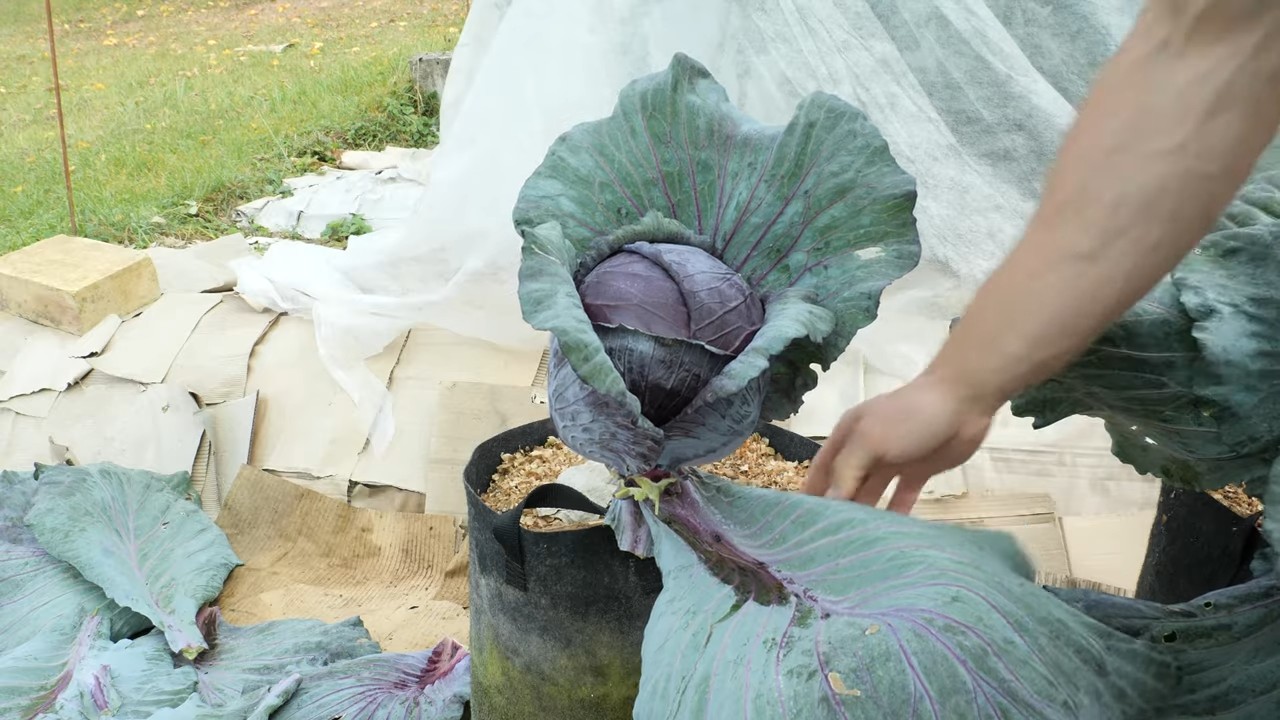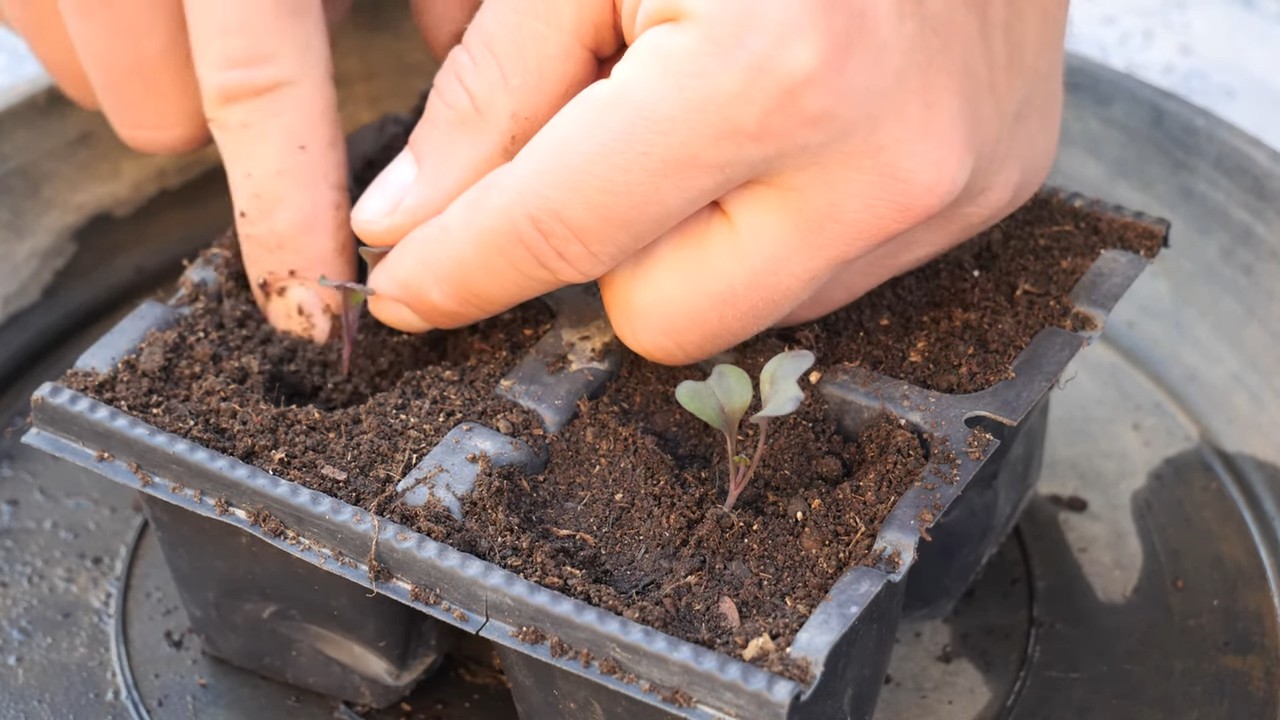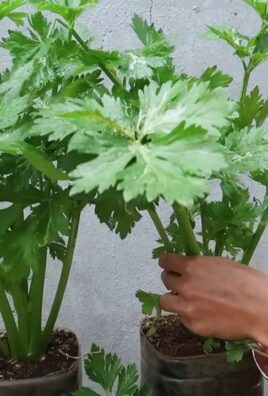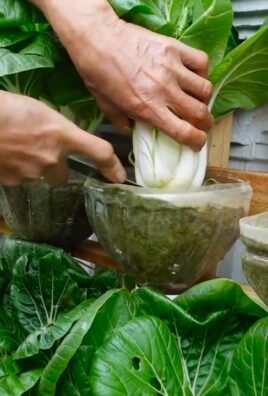Grow Red Cabbage in Pots: Imagine harvesting vibrant, jewel-toned red cabbages right from your own patio! It’s easier than you think, and this DIY guide will show you exactly how to do it. For centuries, cabbage has been a staple in diets around the world, from sauerkraut in Germany to kimchi in Korea. But did you know you don’t need acres of farmland to enjoy this nutritious and delicious vegetable?
Many people shy away from growing their own vegetables, thinking it requires vast gardens and expert knowledge. But that’s simply not true! With a few simple tricks and the right setup, you can successfully grow red cabbage in pots, even if you have limited space. This DIY project is perfect for apartment dwellers, balcony gardeners, or anyone who wants to add a touch of homegrown goodness to their meals.
Why should you bother? Fresh, homegrown red cabbage tastes amazing, and it’s packed with vitamins and antioxidants. Plus, there’s something incredibly satisfying about nurturing a plant from seed to harvest. This guide will provide you with all the information you need to successfully grow red cabbage in pots, from choosing the right container and soil to preventing pests and diseases. Let’s get started and turn your small space into a thriving edible garden!

Growing Red Cabbage in Pots: A Beginner’s Guide
Hey there, fellow gardening enthusiasts! Ever thought about growing your own vibrant red cabbage? It’s easier than you might think, and doing it in pots is perfect if you’re short on space or just want to keep things contained. I’ve been growing red cabbage in pots for a few years now, and I’m excited to share my tips and tricks with you. Let’s get started!
Choosing the Right Pot and Soil
First things first, you need to pick the right container and soil. This is crucial for healthy cabbage growth.
* Pot Size: Red cabbage needs room to grow, so opt for a pot that’s at least 12 inches in diameter and 12 inches deep. A 5-gallon pot is a good starting point, but bigger is always better! I personally prefer using 10-gallon pots because they give the roots plenty of space to spread out.
* Drainage: Make sure your pot has drainage holes. Cabbage doesn’t like sitting in soggy soil. If your pot doesn’t have enough drainage, you can drill a few extra holes in the bottom.
* Soil: Use a well-draining potting mix that’s rich in organic matter. I like to mix equal parts of compost, peat moss (or coconut coir), and perlite. This combination provides good drainage, aeration, and nutrients. Avoid using garden soil, as it can be too heavy and compact in pots.
Starting from Seed or Seedlings
You have two options here: starting from seed or buying seedlings from a nursery. Both work well, but starting from seed gives you more control over the entire process.
* Starting from Seed:
* Timing: Start your seeds indoors about 6-8 weeks before the last expected frost. Red cabbage needs a long growing season, so getting a head start indoors is essential.
* Seed Starting Mix: Use a seed starting mix, which is finer and lighter than regular potting mix.
* Planting: Sow the seeds about ¼ inch deep in small pots or seed trays. Keep the soil moist but not soggy.
* Germination: Place the pots in a warm location (around 70-75°F) and keep them consistently moist. Germination usually takes about 5-10 days.
* Light: Once the seedlings emerge, provide them with plenty of light. A sunny windowsill or a grow light will work well.
* Hardening Off: Before transplanting the seedlings outdoors, you need to harden them off. This means gradually exposing them to outdoor conditions over a period of 1-2 weeks. Start by placing them outside for a few hours each day, gradually increasing the amount of time they spend outdoors.
* Buying Seedlings:
* Choosing Seedlings: Select healthy-looking seedlings with sturdy stems and no signs of pests or diseases. Avoid seedlings that are root-bound (roots circling the bottom of the pot).
* Transplanting: Gently remove the seedlings from their containers and plant them in your prepared pots.
Planting Your Red Cabbage
Now comes the fun part – planting your red cabbage!
1. Prepare the Pot: Fill your pot with the well-draining potting mix, leaving about an inch or two of space at the top.
2. Dig a Hole: Dig a hole in the center of the pot that’s large enough to accommodate the root ball of your seedling.
3. Plant the Seedling: Gently remove the seedling from its container and place it in the hole. Make sure the top of the root ball is level with the soil surface.
4. Backfill: Fill in the hole with potting mix and gently firm the soil around the base of the plant.
5. Water Thoroughly: Water the plant thoroughly after planting. This will help settle the soil and encourage root growth.
Caring for Your Red Cabbage
Red cabbage needs consistent care to thrive. Here’s what you need to do:
* Watering: Water your red cabbage regularly, especially during hot, dry weather. The soil should be consistently moist but not soggy. Check the soil moisture by sticking your finger into the soil. If the top inch feels dry, it’s time to water.
* Fertilizing: Red cabbage is a heavy feeder, so it needs regular fertilization. Use a balanced fertilizer (e.g., 10-10-10) every 2-3 weeks. You can also use organic fertilizers like compost tea or fish emulsion. I personally love using compost tea because it’s easy to make and provides a slow-release source of nutrients.
* Sunlight: Red cabbage needs at least 6 hours of sunlight per day. Place your pots in a sunny location where they’ll get plenty of light.
* Weeding: Keep the area around your red cabbage free of weeds. Weeds can compete with your cabbage for nutrients and water.
* Pest Control: Red cabbage can be susceptible to pests like cabbage worms, aphids, and flea beetles. Here are some tips for controlling pests:
* Handpicking: Regularly inspect your plants for pests and handpick them off. This is a simple and effective way to control small infestations.
* Insecticidal Soap: Spray your plants with insecticidal soap to kill aphids and other soft-bodied insects.
* Bacillus Thuringiensis (Bt): Use Bt to control cabbage worms. Bt is a natural bacterium that’s toxic to caterpillars but harmless to humans and other animals.
* Row Covers: Use row covers to protect your plants from pests. Row covers are lightweight fabric covers that you can place over your plants.
* Supporting the Head: As the cabbage head grows larger, it may need support. You can use a stake or a tomato cage to support the head and prevent it from falling over.
Harvesting Your Red Cabbage
Harvest time is the most rewarding part of growing red cabbage!
1. Timing: Red cabbage is typically ready to harvest about 70-80 days after transplanting. The head should be firm and dense.
2. Checking for Ripeness: Gently squeeze the cabbage head. If it feels firm and solid, it’s ready to harvest.
3. Harvesting: Use a sharp knife to cut the cabbage head from the stem. Leave a few outer leaves on the plant, as they can help protect the remaining stem from pests and diseases.
4. Storing: Store your red cabbage in the refrigerator. It will keep for several weeks.
Troubleshooting
Even with the best care, you might encounter some problems while growing red cabbage. Here are some common issues and how to fix them:
* Yellowing Leaves: Yellowing leaves can be a sign of nutrient deficiency. Make sure you’re fertilizing your plants regularly with a balanced fertilizer.
* Stunted Growth: Stunted growth can be caused by a variety of factors, including poor soil, lack of sunlight, and pest infestations. Make sure your plants have well-draining soil, plenty of sunlight, and are free of pests.
* Splitting Heads: Splitting heads can be caused by inconsistent watering. Water your plants regularly and avoid letting the soil dry out completely.
* Bolting: Bolting (premature flowering) can be caused by hot weather. Try to plant your red cabbage in the spring or fall to avoid the hottest months of the year.
Extra Tips for Success
Here are a few extra tips to help you grow the best red cabbage possible:
* Choose the Right Variety: Some red cabbage varieties are better suited for container gardening than others. Look for compact varieties like ‘Red Express’ or ‘Ruby Ball’.
* Rotate Your Crops: Avoid planting red cabbage in the same pot year after year. Rotating your crops can help prevent soilborne diseases and pest infestations.
* Mulch: Apply a layer of mulch around your plants to help retain moisture and suppress weeds.
* Companion Planting: Plant companion plants like dill, chamomile, and rosemary near your red cabbage to attract beneficial insects and deter pests.
* Enjoy Your Harvest: Red cabbage is delicious in salads, slaws, and stir-fries. Experiment with different recipes and enjoy the fruits (or vegetables!) of your labor.
Growing red cabbage in pots is a rewarding experience. With a little bit of care and attention, you can enjoy fresh, homegrown cabbage all season long. Happy gardening!

Conclusion
So, there you have it! Growing red cabbage in pots is not only achievable, but it’s also a remarkably rewarding experience. We’ve walked you through the steps, from selecting the right pot and soil to nurturing your seedlings and protecting them from pests. But why should you take the plunge and try this DIY gardening project?
Firstly, growing your own red cabbage offers unparalleled freshness. Imagine the vibrant color and crisp texture of a freshly harvested red cabbage, ready to be transformed into a delicious slaw, a hearty soup, or a colorful addition to your salads. Store-bought cabbage simply can’t compare to the flavor and nutritional value of homegrown produce.
Secondly, container gardening provides incredible flexibility. Whether you have a sprawling backyard or a tiny balcony, you can enjoy the benefits of growing your own vegetables. Pots allow you to control the growing environment, ensuring optimal conditions for your red cabbage to thrive, regardless of your local climate or soil quality. This is especially useful if you have poor soil conditions in your garden.
Thirdly, it’s a fantastic way to connect with nature and learn about the growing process. From the moment you sow the seeds to the day you harvest your mature cabbage, you’ll gain a deeper appreciation for the natural world and the effort that goes into producing the food we eat. It’s a truly satisfying and educational experience, especially for families with children.
But the benefits don’t stop there! Growing red cabbage in pots is also a cost-effective way to supplement your grocery bill. A single red cabbage plant can yield a substantial head of cabbage, saving you money at the supermarket and reducing your reliance on commercially grown produce.
Ready to get creative? Consider these variations to personalize your red cabbage growing experience:
* Companion Planting: Plant marigolds or nasturtiums around your red cabbage to deter pests naturally. Their bright colors and strong scents can help keep unwanted insects away.
* Succession Planting: Stagger your planting schedule to enjoy a continuous harvest of red cabbage throughout the growing season. Sow new seeds every few weeks to ensure a steady supply.
* Different Varieties: Experiment with different varieties of red cabbage to discover your favorite flavor and texture. Some varieties are sweeter, while others are more compact and suitable for smaller pots.
* Vertical Gardening: If space is limited, consider using a vertical planter to grow your red cabbage. This is a great way to maximize your growing area and add visual interest to your garden.
We’re confident that you’ll find growing red cabbage in pots to be a fun, rewarding, and delicious experience. So, grab your pots, soil, and seeds, and get started today! Don’t forget to document your progress and share your photos and tips with us. We can’t wait to see your beautiful red cabbage creations! We encourage you to share your experiences and any unique tips you discover along the way. Let’s build a community of thriving red cabbage growers!
Now, let’s address some frequently asked questions to ensure your success:
Frequently Asked Questions (FAQ)
Q: What size pot is best for growing red cabbage?
A: A pot that is at least 12 inches in diameter and 12 inches deep is recommended for growing red cabbage. This provides enough space for the roots to develop properly and supports the growth of a healthy head of cabbage. Larger pots (15-18 inches) are even better, especially for larger varieties of red cabbage. The key is to ensure adequate drainage to prevent waterlogging, which can lead to root rot.
Q: What type of soil should I use for growing red cabbage in pots?
A: Red cabbage thrives in well-draining, fertile soil that is rich in organic matter. A good potting mix specifically formulated for vegetables is ideal. You can also amend your own potting mix by combining equal parts of compost, peat moss (or coconut coir), and perlite or vermiculite. The compost provides essential nutrients, the peat moss or coconut coir helps retain moisture, and the perlite or vermiculite improves drainage. Aim for a soil pH between 6.0 and 7.0 for optimal growth.
Q: How often should I water my red cabbage plants in pots?
A: Water your red cabbage plants regularly, especially during hot and dry weather. The soil should be kept consistently moist, but not waterlogged. Check the soil moisture level by sticking your finger about an inch deep into the soil. If it feels dry, it’s time to water. Water deeply, allowing the water to drain out of the bottom of the pot. Avoid overhead watering, as this can increase the risk of fungal diseases.
Q: How much sunlight does red cabbage need?
A: Red cabbage requires at least 6 hours of direct sunlight per day to thrive. Choose a sunny location for your pots where the plants will receive ample sunlight throughout the day. If you live in a particularly hot climate, some afternoon shade may be beneficial to prevent the leaves from scorching.
Q: What are some common pests and diseases that affect red cabbage, and how can I prevent them?
A: Common pests that affect red cabbage include cabbage worms, aphids, and flea beetles. To prevent these pests, you can use row covers to protect your plants, handpick any pests you see, or apply organic insecticides such as Bacillus thuringiensis (Bt) for cabbage worms or insecticidal soap for aphids and flea beetles. Common diseases include clubroot and black rot. To prevent these diseases, ensure good drainage, avoid overhead watering, and practice crop rotation.
Q: How do I fertilize my red cabbage plants in pots?
A: Red cabbage is a heavy feeder and requires regular fertilization to produce a healthy head. Start fertilizing your plants about two weeks after transplanting them into their pots. Use a balanced fertilizer (e.g., 10-10-10) or a fertilizer specifically formulated for vegetables. Follow the instructions on the fertilizer label for application rates. You can also supplement with organic fertilizers such as compost tea or fish emulsion. Fertilize every 2-3 weeks throughout the growing season.
Q: When is the best time to harvest red cabbage?
A: Red cabbage is typically ready to harvest about 70-80 days after transplanting. The head should be firm and compact, and the leaves should be tightly packed. To harvest, use a sharp knife to cut the head from the stem, leaving a few outer leaves intact. You can store harvested red cabbage in the refrigerator for several weeks.
Q: Can I grow red cabbage in pots during the winter?
A: In mild climates, you may be able to grow red cabbage in pots during the winter. However, in colder climates, you will need to provide protection from frost and freezing temperatures. You can move the pots indoors to a sunny location or cover them with a frost blanket. Red cabbage can tolerate light frost, but prolonged exposure to freezing temperatures can damage the plants.
Q: What are some good companion plants for red cabbage in pots?
A: Good companion plants for red cabbage include marigolds, nasturtiums, dill, rosemary, and thyme. These plants can help deter pests, attract beneficial insects, and improve the overall health of your red cabbage plants. Avoid planting red cabbage near other members of the brassica family, such as broccoli, cauliflower, and kale, as they can attract the same pests and diseases.
Q: Can I save seeds from my red cabbage plants?
A: Saving seeds from red cabbage can be challenging, as it is a biennial plant, meaning it typically takes two years to produce seeds. If you want to save seeds, you will need to overwinter your plants and allow them to flower and produce seeds in the second year. However, keep in mind that red cabbage is often cross-pollinated, so the seeds may not produce plants that are true to type.




Leave a Comment